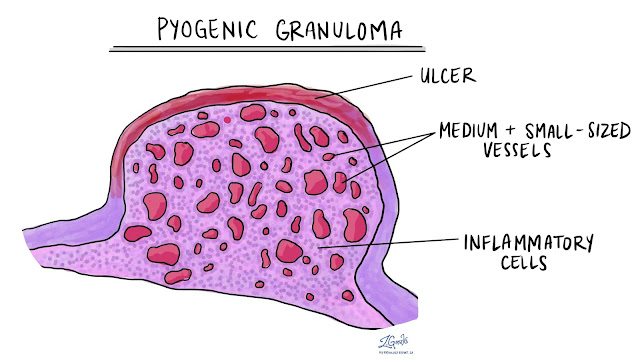Pyogenic Granuloma Hemangioma
Pyogenic Granuloma Hemangioma, often referred to as pyogenic granuloma, is a common and benign vascular growth found on the skin or mucous membranes. Despite its name, it's neither infectious nor a true granuloma but rather a rapidly growing lesion composed of blood vessels. Understanding its origins and characteristics is crucial for proper identification and treatment.
Symptoms of Pyogenic Granuloma Hemangioma
These growths usually appear as small, reddish bumps that tend to bleed easily, making them more noticeable. They can develop anywhere on the body but are frequently found on the hands, arms, face, and neck. Some may experience discomfort or pain if the lesion is in a sensitive area.
Diagnosis and Identification
Diagnosing pyogenic granuloma involves a physical examination by a healthcare professional. Often, a biopsy or other tests may be conducted to rule out other conditions with similar appearances.
Treatment Options
Treatment typically involves removal through various methods, including surgical excision, cryotherapy, laser therapy, or medication. Home remedies like apple cider vinegar or tea tree oil are sometimes attempted but should be used cautiously.
Complications and Risks
While pyogenic granulomas are generally harmless, complications such as excessive bleeding or recurrence after removal may occur. Certain factors like hormonal changes during pregnancy can contribute to their development.
Also Read: Diabetes Retinopathy Symptoms
Preventive Measures
Although there's no guaranteed prevention, practicing good skincare and promptly treating any injury or irritation to the skin may reduce the risk of developing these lesions.
Impact on Daily Life
The presence of pyogenic granuloma can cause distress due to their appearance, especially in visible areas. Seeking support from healthcare professionals and support groups can assist in coping with the emotional aspects.
Understanding the Medical Perspective
Researchers continue to study the underlying causes and potential treatments for pyogenic granuloma hemangioma. Advancements in technology and medical interventions offer hope for more effective management in the future.
Case Studies and Real-life Experiences
Many individuals have successfully managed pyogenic granulomas through various treatments. Sharing these experiences can provide reassurance and guidance to others facing similar situations.
Community Support and Resources
Support groups and online communities dedicated to dermatological conditions often offer a wealth of information and emotional support for individuals dealing with pyogenic granulomas.
FAQs about Pyogenic Granuloma Hemangioma
Are pyogenic granulomas cancerous?
Pyogenic granulomas are benign and non-cancerous growths.
Can pyogenic granulomas go away on their own?
Rarely, they might spontaneously regress, but most require treatment for removal.
Are there any long-term effects of having pyogenic granulomas?
Typically, once removed, there are no long-term effects. However, recurrence can happen in some cases.
Can I prevent pyogenic granulomas from occurring?
While prevention isn’t guaranteed, avoiding trauma to the skin can lower the risk.
Do pyogenic granulomas cause pain?
They might be tender or bleed easily but aren’t usually painful.
Conclusion
Understanding pyogenic granuloma hemangioma is essential for proper identification and treatment. Seeking professional medical advice for accurate diagnosis and appropriate treatment options is crucial for managing this condition effectively.




Comments
Post a Comment